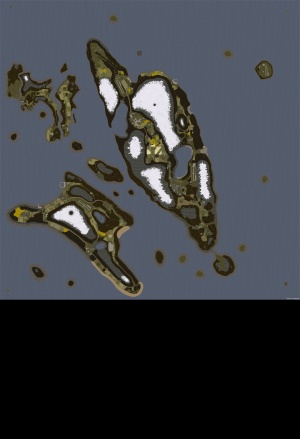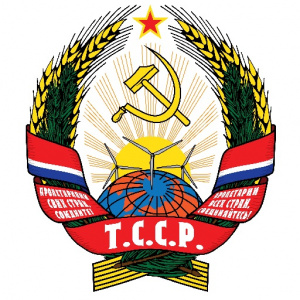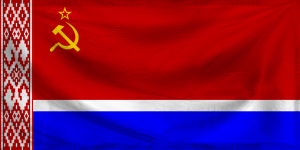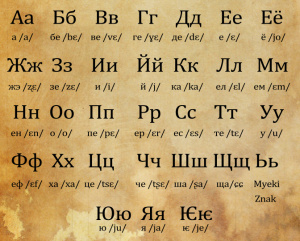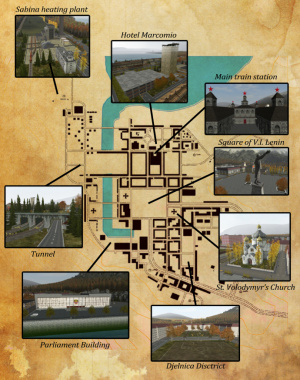Taviana S.S.R
Contents
About
Taviana (Officially: Tavianska Sovjetskaja Socialističiskaja Respublika - TSSR– The Soviet Socialist Republic of Taviana) is an island country situated in the Baltic Sea approximately 120km off the coast of Lithuania or Kaliningrad on a volcanic island formation which it shared with Novistrana (Officially: Novistranskaja Sovjetskaja Socialističiskaja Respublika - NSSR - The Soviet Socialist Republic of Novistrana. Taviana has a population of approximately 1 500 000 inhabitants of who 90% are ethnic Slavs called “Rustaki”, Russians or Poles and 10% ethnic Lithuanians. The capital and second largest city of the republic is Sabina which is located on the Southern coast of lake Umag, has a population of approximately 150 000 and has the republics main international airport.
The republic is made up of two islands, the bigger of which, on which the capital is located is called Bukvac – named after the mythical Slavic creature which lurks around lakes at night due to the numerous lakes on the island. The smaller island is called Ostrov Leš (Lesh), named after the Slavic spirit which guards forests at night dude to the islands large forests. The capital of Lesh, and third largest city in the republic is Lesh, and third largest city in the republic is Branibor, situated near the republics only nuclear power station AES Trebljanka.
Click here to see all the map features.
Language
The official spoken language on Taviana is Tavianian (Tavijanski Jazik) which is an Eastern Slavic language written in a variation of the Belarusian Cyrillic alphabet. Lithuanian, Russian and Polish are also officially recognised languages of the republic.
Religion
The largest religious group consisting of 70% of Tavianas population are Orthodox Christians, the second major religious group in the republic are Catholics consisting of approximately 15% population where as 15% of the population have no religion.
Independence And The Revolution
Following the 1917 uprising against the Tsarist autocracy Taviana gained independence from the Russian empire and established a Socialist government lead by the SPT (Socialističiskaja Partija Taviany – The Socialist party of Taviana) to the present day. A 50 meter statue of Lenin was also built in the capital cities main square called (Sredmestje Vladimira Iliča Lenina - The Square of Vladimir Illich Lenin) to commemorate the 1917 revolution.
Economy
Approximately 50% Tavianas economy consists of the extraction of natural resources such as oil and gas which are drilled mainly on the islands North coasts. Fishing and farming form another 35% of the republics economy while heavy industry such as metal works, chemical plants and shipyards from the remaining 15% of the economy.
Sabina (Capital City)
The capital and largest city on Taviana Island is Sabina. The city was founded in the year 1241 by king Solibor, following the war with Norwegian invaders in which he successfully defeated the invaders by taking advantage of the islands terrain despite being outnumbered 3 to 1. The city was named after his wife Sabina who he married in the same year. Legend has it that on the site where St. Volodymyr’s church now stands, a castle used to stand in which queen Sabina was church now stands, a castle used to stand in which queen Sabina was held and rescued by king Solibor himself. The most prominent feature of the city is the statue of Vladimir Lenin in the square of the Revolution erected after the 1917 Bolshevik revolution. The square of the Revolution is also where the notional bank of Taviana is located, as well as the national museum and library. The national museum was built in 1886 alongside the national university located beside it. The capital city also contains the national university located beside it. The capital city also contains the national gallery and a number of large shopping centers. Some of the more recent architectural achievements in the capital is the parliament building, based on the GDR parliament building in East Berlin or Hotel Marcomio which is the tallest structure in the city. The capital also contains a 750 meter underground tunnel complete with a train station built in 1927 by the communist party.
Wars
874 – The first recorded conflict on Taviana took place on the site where today’s port Molotovsk stands in the year 874 between Slavic migrants from the East and native Nordic inhabitants which were eventually forced out of the island.
1240 – 1241 – In the year 1240 Norwegian forces invaded Taviana in an attempt to conquer the island but were forced out one year later in the final battle that took place on the fields of Stari Bor.
1015 – In the year 1015 the Roman empire launched a series of failed attempts to conquer the island.
1600-1611 – In the years between 1600 – 1611 Taviana was invaded by Swedish forces during the Polish-Swedish war but where forced off the island by Polish forces in the battle on the fields on Novi Bor.
1625-1629 – In the years between 1625 – 1629 Taviana took part in the Polish-Swedish war fighting on the Polish side.
1914–1918 (World war 1) - Taviana remained mostly untouched by World War 1 although some conflicts were fought in Prussia and Kaliningrad in attempts to seize the provinces from German control. The years between 1914 – 1918 also saw the Bolshevik revolution of 1917 which gave Taviana independence from Tsarist rule and in which the Socialist Republic of Taviana was born and the crush of the uprising of the predominantly Russian Novistrana to breakaway from Taviana.
1939–1945 (World War 2) – World War 2 was a very dark chapter in Taviana’s History. The island was invaded by the Third Reich which forced the Socialist government and the Taviana armed forces in to exile in the Soviet Union where the Taviana armed forces merged with the Red Army and fought against the Third Reich. While fighting continued the Jewish population of Taviana was deported to death camps in Poland while the native population of Taviana was forced in to labour, manufacturing weapons.
1948 - The Soviet Leader Joseph Stalin seeks to ease tensions in the Baltic area and rewards Novistrana with their own Soviet Republic, thus establishing the N.S.S.R and T.S.S.R.
In the last phases of World War 2 Taviana was liberated by Red army troops and surviving troops of the Taviana armed forces who reinstalled the socialist government.
1945 Onwards – From 1945 onwards Taviana saw a large number of Lithuanian, Russian and Polish migrants feeling from the destroyed European mainland who took on the task of re-building the republic. Today Taviana is still one of the Soviet Union’s key allies and serves as an important strategic location for the Soviet Union as well as a important submarine repair base.
